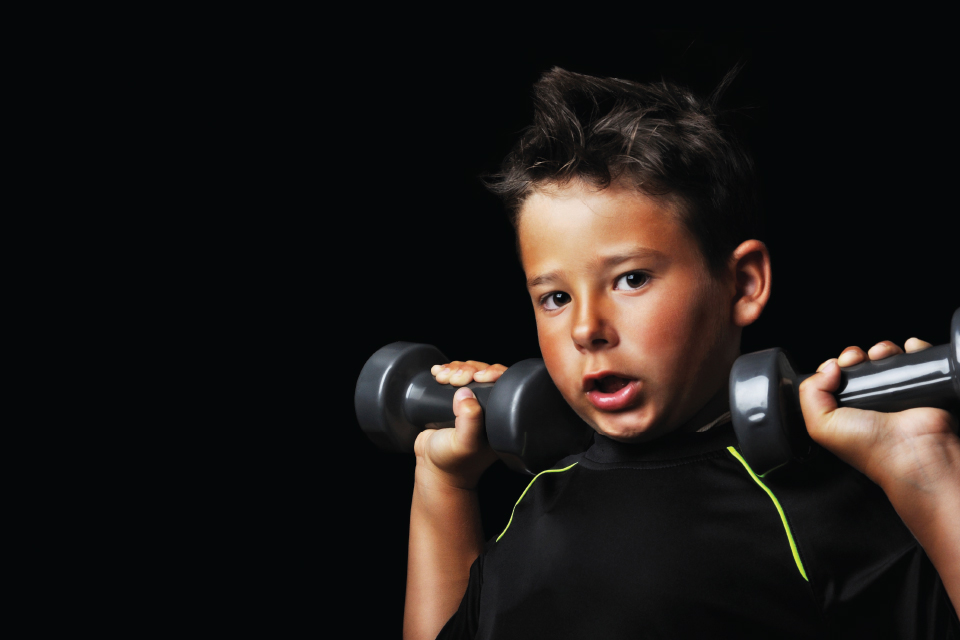Eye on the Pride

It’s another sweltering summer afternoon in Austin, but inside the burnt orange brick walls of Spirit Fitness Training the cool wood gym floor is awash with a smattering of kids ages 7 to 17—all of them working up a sweat to develop their strength and conditioning skills.
While at first glance, it may appear as though these kids are training to enhance their sports performance skills or garner higher athletic achievement, they have no such intention. They are simply training to improve their overall health, mobility, body awareness, and self-confidence. Although the pride this group takes in their accomplishments at the gym is collective and contagious, their personal goals are as distinct and individual as the physical difficulties they face.
The group got its start four months ago when Laurie, mother of 9-year-old twin boys, Ben and Thomas, approached me (a trainer at Spirit Fitness) seeking a special kind of exercise regimen for her kids. Her boys were both spunky in energy, with bright eyes, irresistible smiles, and adventurous spirits. While similar in age and stature, one of the twins, Ben, had been regularly attending occupational therapy sessions to help improve his motor control skills, focus, and postural awareness. Unlike his brother and the rest of the kids bouncing around the gym floor on this day, Ben learns and moves differently, perhaps even awkwardly by some standards.
“He doesn’t move the same way [as other boys his age],” Laurie says. “He’s not spatially aware, so running, jumping, and riding a bike are all big challenges.”
After he was diagnosed with autism spectrum disorder (ASD) and attention deficit hyperactivity disorder (ADHD), Ben’s parents knew they needed to place just as much emphasis on their son’s academic instruction as they did his physical skill training.
After several years of driving Ben to and from occupational therapy sessions, his mom was growing increasingly concerned that the body awareness and core training offered at the sessions weren’t physically challenging enough for a growing boy.
“Not to mention, while the rest of your friends are heading off to football practice after school, occupational therapy isn’t exactly an activity a 9-year-old brags about to his friends,” Laurie says.
She wants Ben to be physically aware and strong despite any learning and developmental issues he has to face.
“I want him to walk tall and feel confident in his own body. He may never choose to be an athlete, but I want him to know the confidence a well-conditioned and coordinated body brings,” she says.
Her hopes for her son are not unique.
However, more often than not, parents with children diagnosed with ASD or ADHD tend to feel lost about how to motivate their children to engage in physically challenging activities that will foster health and fitness.
The Simons Foundation, a research program focused on the understanding, diagnosis and treatment of autism spectrum disorders, says that children with autism spend more time than their peers playing video games and watching television—suggesting that the time spent engaged with their electronics detracts from potential time spent participating in fitness-related activities.
Another hurdle is that, according to a study published on AutismSpeaks.org, for children challenged with limited motor functioning, low motivation, or difficulty in planning, “physical activity involving social interaction—such as team sports—can present a difficult situation.”
“Team sports require an athletic ability and an attention span, which may be unsuitable for kids with developmental disorders,” Laurie says. “Even self-paced sports like gymnastics or karate require a level of discipline and coordination these kids generally do not have.”
For kids with disabilities, multiple barriers—whether a product of one’s social environment or physical predisposition—stand in the way of fitness. Hence, many parents are apprehensive to encourage their children to become involved in activities because of the range of obstacles they are likely to encounter. Yet, many resources and gyms are making it possible for children with disabilities to participate in recreational fitness.
For the past four months, Ben and a few other kids (who face similar spatial and operational challenges) can be found working out with Spirit Fitness trainers at least three times a week—walking, running, jumping, throwing, crawling and playing alongside their peers. Like professional athletes training for competition, they incorporate agility ladders, cones, and jump ropes into their routine to improve their concentration, coordination, and reaction time—sneaking in the occasional beanbag or wobble board to enhance their balance.
Parents with kids in the program report that their children have experienced unparalleled motor skills improvement. And while their time at the gym cannot replace the invaluable visual perception, cognition, problem solving, sequencing, and life skills provided by occupational therapy, fitness is a great addition to the weekly routine. Through hard work, they’ve learned how to ride bikes, jump rope, swing on swings, and catch balls. To the average 9-year-old athlete, these activities may not sound like a big deal, but for these kids mastering them is a game changer.
“[Now] Ben strides instead of stumbling and catches a ball without wincing,” Laurie says, her lips breaking into a smile.
“If you've ever watched your child struggle with something that comes so easily to another child, then you know the heartbreak. It’s going to be a long, hard road for my son, but I want to be able to give him every leg-up in life,” Laurie says. “Strengthening his body is the one thing I know he can do to help all those other struggles become a little bit less of a struggle.”






